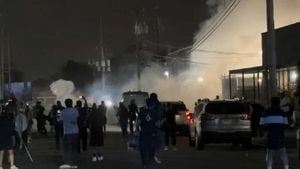In a dramatic turn of events that has left political observers both inside and outside Nepal stunned, a sweeping youth-led anti-corruption rebellion toppled the government of Prime Minister K P Sharma Oli earlier this month. The speed of Oli’s collapse—just days from unrest to resignation—has sparked debate across Nepal and beyond about what truly fueled this revolution and what the future holds for the Himalayan nation, which is nestled precariously between two global giants, India and China.
According to DW, millions of Nepalese are still processing the aftershocks of the movement, which was spearheaded by urban youth frustrated with years of cronyism and a lack of opportunity. The ouster of Oli’s government was so rapid and decisive that some Nepalese have speculated about possible foreign involvement. A rare congratulatory message from the Dalai Lama only added fuel to the fire on social media, with theories swirling about who might have been pulling the strings from afar. Yet, many voices insist the movement was homegrown. Kathmandu-based journalist Devendra Bhattarai wrote, “The Gen Z campaign is often compared to movements in Bangladesh, Sri Lanka or Syria. But it must not be forgotten that this is less the result of outside influence and more a revolution born and nurtured by Nepali leaders here.”
Political scientist Sucheta Pyakurel echoed this sentiment, describing the government’s ouster as a “revolution of mass frustration” created by the persistent lack of opportunities and rampant cronyism. However, she also pointed out a “correlation between sovereignty and external influence,” noting, “As we lose our grip on both the state institutions and the market—with so many youths leaving for jobs abroad—external influence naturally grows.”
Nepal, home to nearly 30 million people, has long struggled with political instability. Since the adoption of a new constitution in 2015, the country has cycled through eight governments, all centered around the same three leaders: Oli of the Communist Party of Nepal (Unified Marxist–Leninist), Sher Bahadur Deuba of the Nepali Congress, and Pushpa Kamal Dahal of the Communist Party of Nepal (Maoist-Center). According to DW, parts of Nepal’s political scene—especially left-leaning and pro-monarchy factions—have repeatedly claimed that foreign powers such as India, the United States, and the European Union are behind the country’s frequent political upheavals. In recent years, China has also been added to this list, as its traditionally “quiet diplomacy” has taken on a more assertive tone.
Officially, Nepal maintains a “nonaligned foreign policy”—a principle dating back to King Prithvi, who unified the country in 1768. This approach is often summed up as “friendship with all and enmity with none,” a strategy aimed at securing diplomatic and developmental support from all sides, especially India and China. Nepal also considers the United States its “third neighbor” because of America’s global influence. As Chandra Dev Bhatta, a geopolitical analyst, told DW, “Nepal’s foreign policy is all about its efforts to maintain a delicate balance with all three regional and global powers.”
The stakes could hardly be higher. India, which shares a 1,751-kilometer (1,066-mile) open border with Nepal, has deep cultural, economic, and security ties with its northern neighbor. Instability in Nepal has immediate repercussions for India, and New Delhi seeks a reliable partner in Kathmandu to maintain smooth relations. China, on the other hand, shares Nepal’s northern border with Tibet. For Beijing, a stable Nepal is crucial for safeguarding the security of the Tibet Autonomous Region and ensuring that anti-China activities are not launched from Nepali soil. Beijing insists that Nepal uphold the “One China Policy,” and Kathmandu has repeatedly affirmed that Tibet, Hong Kong, Macao, and Taiwan are integral parts of China.
Since 2017, Nepal has been part of China’s Belt and Road Initiative (BRI), with the ambitious goal of building multidimensional trans-Himalayan networks—railways, roads, digital infrastructure, and energy links. Yet, Kathmandu has not put all its eggs in one basket. The United States recently provided a $530 million Millennium Challenge Corporation (MCC) grant to upgrade Nepal’s energy grids and road infrastructure, a move widely seen as a Western counterweight to China’s BRI. Other allies, including the European Union, Japan, South Korea, and Australia, have also lent support through government programs and civil society funding.
Oli’s government, especially in its final years, was seen as tilting toward Beijing. Since Chinese President Xi Jinping’s state visit to Kathmandu in October 2019, Nepal’s left-leaning leaders have made repeated trips to China. Just days before the September 2025 protests erupted, Oli attended a military parade in Beijing marking the 80th anniversary of China’s victory over Imperial Japan. During that visit, Oli raised Nepal’s concerns about an agreement between India and China to open economic and pilgrimage routes through Lipulekh Pass—a territory Nepal has long claimed. On the sidelines, he met with Russian President Vladimir Putin and Indian Prime Minister Narendra Modi.
Complicating matters, the Chinese side later claimed that Nepal had expressed support for the Global Security Initiative (GSI), a still-loosely defined proposal for a security bloc led by China. Such a move would have breached Nepal’s traditional neutrality, but the Nepali government denied that Oli endorsed the GSI. “Since our engagement is greater with India and the West, our strategic tilt toward China could be viewed unfavorably,” Bhatta noted in DW.
The international response to Nepal’s upheaval has been swift and telling. Japan was the first nation to congratulate the regime change, a gesture that many analysts see as a subtle rebuke of Oli’s diplomatic course. The interim government, led by former Supreme Court Justice Sushila Karki, received warm welcomes from India, China, the US, the EU, and the United Nations. On September 16, 2025, Indian Prime Minister Narendra Modi reaffirmed his country’s “steadfast support for her efforts to restore peace and stability” during a phone call with Karki. Meanwhile, China’s Foreign Ministry stated that Beijing “respects the development path chosen independently by the people of Nepal.”
The Karki-led interim government is now focused on organizing elections to transfer power to a newly elected cabinet. While the world watches closely, it remains to be seen how Nepal’s next leaders will navigate the treacherous waters of regional and global geopolitics. Indra Adhikari, a board member of Nepal’s Policy Research Institute, cautioned against complacency: “Nepal should refrain from deviating from its foreign policy mantra of nonalignment and falling into a geopolitical trap.”
For now, Nepal stands at a crossroads—a nation whose young people have demanded change, but whose future will depend on its ability to walk the diplomatic tightrope between competing global powers while staying true to its own aspirations.




